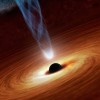Black Holes and Their Coronal Magnetic Field
Did you know that supermassive black holes are the largest type of black hole known to mankind? In fact, they contain a mass that is more than a billion times larger than typical black holes. It has been discovered that the supermassive black holes that lurk at the center of most galaxies are surrounded by coronas, but not much is known about why this occurs or even what coronas look like.
Like the sun, black hole coronas are theoretically believed to be heated by their magnetic activity. Last year, we wrote about just how powerful, or lack-there-of, black holes and their magnetic fields were, but we still didn’t know much about how coronas came into play. Recent research has built on what was previously learned to reveal that the mystery of coronal magnetic fields is still ongoing.
What Exactly is a Corona?
Coronas are sources made up of highly energetic particles that generate x-ray light. While their appearance isn’t exactly known, some astronomers believe coronas form in one of two likely configurations. The first is the “lampost” model, which says the compact sources of light sit above and below the black hole, similar to the shape of light bulbs. The second model is the “sandwich” model, which says the coronas are spread out more diffusely, resembling a cloud or sandwich around the black hole. Other astronomers believe coronas actually take on both of these configurations.
Coronal Magnetic Fields
It’s thought that coronas are controlled by powerful magnetic fields. The strength of their magnetic fields determines the brightness of their jets – which are bits of plasma ejected from the atmosphere through the corona. In 2014, Japanese astrophysicists Yoshiyuki Inoue and Akihiro Doi predicted that electrons in the plasma surrounding black holes would emit a special kind of light — called synchrotron radiation — as they exist together with the magnetic forces in the coronas. In 2018, Inoue and researchers from RIKEN (a large research institute in Japan) and the Japan Aerospace Exploration Agency (JAXA) have used the Atacama Large Millimeter/submillimeter Array (ALMA) to measure the magnetic fields surrounding central supermassive black holes in two active galaxies.
For the first time, the strength of magnetic fields were measured near two supermassive black holes at the center of an important type of active galaxies. They confirmed the emission of radio synchrotron radiation from the coronas in their study but, they also found the strength of these magnetic fields does not appear to be high enough to power the black hole coronas. Yoshiyuki Inoue, the lead author of the paper, published in The Astrophysical Journal, said: “it turns out that the magnetic field we measured is much too weak to be able to drive the intense heating of the coronae around these black holes.” He also notes that the same phenomenon was observed in both galaxies, implying that it could be a general phenomenon.
The research conducted by RIKEN and JAXA seems to have only furthered the mystery surrounding supermassive black holes and their surrounding coronas.
Learn More About Magnetic Findings
For more information on break-through magnetic discoveries, browse through our magnet in the news section.

